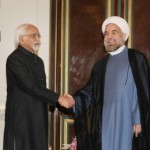Chabahar may be just a blip on the map south of the Persian Gulf but the city boasts of a rich history. The city has endured the armies in the Bronze Age during the Mesopotamian Wars. That’s more than 2,000 years before Alexander the Great’s Macedonians took the city as they swept toward India. [1]
With western countries beginning to lift sanctions on Iran and its oil exports ramping up, Chabahar may soon see a frenzy of economic activity [2] as it is Iran’s only port with direct access to the ocean. Situated near the shipping lane for nearly a fifth of the world’s oil, it makes the city commercially and strategically important. [3, 4]
India traditionally has been one of Iran’s largest oil customers and will provide a big push in this direction. In August, Prime Minister Narendra Modi hosted Iranian Foreign Minister Javad Zarif, pledging $85 million toward the Chabahar port project.
If contract negotiations come off without a hitch, Chabahar could give India access to a prime spot closer to the Persian Gulf than Gwadar port, the final stop on the China-Pakistan Economic Corridor. [5, 6] Gwadar, part of China’s plan to get around the pirate-infested Malacca Strait, may be a big reason why President Xi Jinping promised to invest $46 billion in the route when he visited Pakistan in April.[7, 8]
Trade with Iran doesn’t just give India leverage over China in the Indian Ocean but allows India to sate its domestic demand for oil. [9, 10]
With the renewed economic relationship, India may also hope to temper Iran’s ambitious foreign policy which has even encroached on eastern Afghanistan in the past. But for New Delhi, Tehran can also be a multilateral troublemaker as Iran has used its seat on the Organisation of the Islamic Conference to condemn India’s conduct in Kashmir.[11, 12]
That may have been par for the course. New Delhi has voted against Tehran several times at the International Atomic Energy Agency (IAEA) and enforced sanctions on the Islamic Republic, even after those penalties bit into two Indian companies that traded missile materials to Iran in 2005. [13]
Iran’s cold shoulder, however, was a tough blow to India. The world’s largest democracy houses the world’s second biggest Shia population. According to the Pew Research Center, more Muslims will live in India by mid-century than anywhere else on earth. Ties with Muslim communities outside India will come to weigh heavily on the country’s domestic politics. [14]
Public diplomacy is not the only element of India and Iran’s relationship that has fallen by the wayside. Facing the brunt of sanctions, India cut oil purchases from Iran to just 6% of its imports in 2015. That’s down from nearly three times that amount a few years ago. [15]
But that trend may not hold. India does not have the luxury of choosing its friends and allies from an ocean away. Living in a neighborhood with failing democracies and endemic poverty, India must go to great lengths to preserve energy relationships and political alliances, even if those ties aren’t built to last.
So Iran, likely, for the time being, will enter India’s fractious coalition. It is not a reliable ally, but India, feeling its way through a complex neighbourhood, can’t little hope for reliability. What it needs now are alliances, energy, and facilities. For now, Iran can offer some of that.
Jack Detsch is a writer, researcher, and journalist based in the San Francisco Bay Area. Detsch has written on local, national, and international affairs for The Diplomat, The National Interest, and the NPR-affiliated KQEDPublic Radio. He is a graduate of the Elliott School of International Affairs at the George Washington University.
This article was exclusively written for Gateway House: Indian Council on Global Relations. You can read more exclusive content here.
For interview requests with the author, or for permission to republish, please contact outreach@gatewayhouse.in.
© Copyright 2015 Gateway House: Indian Council on Global Relations. All rights reserved. Any unauthorized copying or reproduction is strictly prohibited
References
[1] The Air University, ‘The Armies of Sumer and Akkad, 3500-2200 BC’, Chapter 2 – The World’s First Armies, <http://www.au.af.mil/au/awc/awcgate/gabrmetz/gabr0004.htm>
[2] World Bank, ‘Iran: Lifting of Sanctions Will Lower Oil Prices and Boost Domestic Economy If Managed Well,’10 August 2015,< http://www.worldbank.org/en/news/press-release/2015/08/10/iran-lifting-sanctions-will-lower-oil-prices-and-boost-domestic-economy-if-managed-well>
[3] NDTV, ‘Chabahar Port, Indian Prisoners Figure in Indo-Iran Talks’, 15 August, 2015, <http://www.ndtv.com/india-news/chabahar-port-indian-prisoners-figure-in-indo-iran-talks-1207480>
[4] U.S. Department of Energy, ‘World Oil Transit Chokepoints’, 10 November 2014, <http://www.eia.gov/beta/international/regions-topics.cfm?RegionTopicID=WOTC>
[5] Economics Times, ‘Chabahar Port: India, Iran’s plan to build railway link faces hurdles’, 26 August 2015, <http://articles.economictimes.indiatimes.com/2015-08-26/news/65886948_1_rail-link-chabahar-port-railway-link>
[6] The Hindu, ‘Decks cleared for India’s role in Iranian port’, 27 August 2015, <http://www.thehindu.com/news/national/decks-cleared-for-indias-role-in-irans-chabahar-port/article7583968.ece>
[7] The Diplomat, ‘China’s Grand Plan for Pakistan’s Infrastructure’, 21 April 2015, <http://thediplomat.com/2015/04/chinas-grand-plan-for-pakistans-infrastructure/>
[8] BBC, ‘China’s Xi Jinping agrees $46bn superhighway to Pakistan’, 20 April 2015, <http://www.bbc.com/news/world-asia-32377088>
[9] The Diplomat, ‘The Mixed Consequences of Sino-Indian Competition in the Indian Ocean’, 28 January 2015, <http://thediplomat.com/2015/01/the-mixed-consequences-of-sino-indian-competition-in-the-indian-ocean/>
[10] Forbes, ‘India’s Rise To 3rd Place In Oil Demand’, 7 August 2015, <http://www.forbes.com/sites/judeclemente/2015/08/07/indias-rise-to-3rd-place-in-oil-demand/>
[11] The Christian Science Monitor, ‘Is Iran meddling in Afghanistan?’, 8 August 2007, <http://www.csmonitor.com/2007/0808/p06s01-wosc.html>
[12] Foreign Policy, ‘India’s Iran calculus’, 24 September 2010, <http://foreignpolicy.com/2010/09/24/indias-iran-calculus/>
[13] Rediff, ‘2 Indian firms to face US sanctions’, 27 December 2005, <http://in.rediff.com/money/2005/dec/27us.htm>
[14] Pew Research Center, ‘The Future of World Religions: Population Growth Projections, 2010-2050’ 2 April 2015, <http://www.pewforum.org/2015/04/02/religious-projections-2010-2050/>
[15] Federation of American Scientists, ‘Iran Sanctions’, 3 November 2015, <https://www.fas.org/sgp/crs/mideast/RS20871.pdf >


